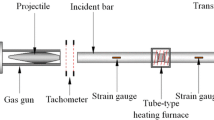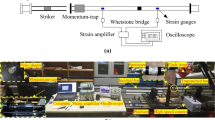Abstract
In the mining of geothermal resources, understanding the physical and mechanical behavior of a rock with preexisting thermal damage is necessary to control the stability of the mining process. Herein we report mechanical testing results on a granite subjected to eight initial thermal damage conditions. The results indicate that the P-wave velocity, thermal conductivity, and uniaxial compressive strength increase first and then decrease with the increase of initial temperature in the range of 25∼600 °C. The rate characteristics of acoustic emission cumulative energy curve, the compressive deformation process of specimen were divided into four groups, and a uniaxial compressive damage parameter was established to quantify the failure mode from tensile to shear failure with the increase of the initial temperature. A variable-order fractional compressive constitutive model considering initial temperature damage was established. The model was validated with experimental data. The mechanisms of initial damaging temperature and viscosity coefficient on the compressive deformation curves were identified.


















Similar content being viewed by others
References
Cai, W., Wang, P., Fan, J.J.: A variable-order fractional model of tensile and shear behavior for sintered nanosilver paste used in high power electronics. Mech. Mater. 145, 103391 (2020). https://doi.org/10.1016/j.mechmat.2020.103391
Chen, Y.L., Ni, J., Shao, W., Azzam, R.: Experimental study on the influence of temperature on the mechanical properties of granite under uni-axial compression and fatigue loading. Int. J. Rock Mech. Min. Sci. 56, 62–66 (2012). https://doi.org/10.1016/j.ijrmms.2012.07.026
Chen, Y.L., Wang, S.R., Ni, J., Azzam, R., Fernandez-Steeger, T.M.: An experimental study of the mechanical properties of granite after high temperature exposure based on mineral characteristics. Eng. Geol. 220, 234–242 (2017). https://doi.org/10.1016/j.enggeo.2017.02.010
Cho, W.J., Kwon, S.: Estimation of the thermal properties for partially saturated granite. Eng. Geol. 115, 132–138 (2010). https://doi.org/10.1016/j.enggeo.2010.06.007
Coimbra, C.F.M.: Mechanics with variable order differential operators. Ann. Phys. Berlin 12, 692–703 (2003). https://doi.org/10.1002/andp.200310032
Feng, G., Zhu, C., Wang, X.C., Tang, S.B.: Effects of different temperatures on the accuracy of the MMTS criterion in predicting fracture behavior of dense granite from a potential geothermal development area. J. Rock Mech. Geotech. Eng. (2022). https://doi.org/10.1016/j.jrmge.2022.12.003
Fu, H.L., Zhang, J.B., Huang, Z., Shi, Y., Chen, W.: A statistical model for predicting the triaxial compressive strength of transversely isotropic rocks subjected to freeze-thaw cycling. Cold Reg. Sci. Technol. 145, 237–248 (2018). https://doi.org/10.1016/j.coldregions.2017.11.003
Gautam, P.K., Verma, A.K., Jha, M.K., Sharma, P., Singh, T.N.: Effect of high temperature on physical and mechanical properties of Jalore granite. J. Appl. Geophys. 159, 460–474 (2018). https://doi.org/10.1016/j.jappgeo.2018.07.018
Ge, Z.L., Sun, Q.: Acoustic emission (AE) characteristics of granite after heating and cooling cycles. Eng. Fract. Mech. 200, 418–429 (2018). https://doi.org/10.1016/j.engfracmech.2018.08.011
Glover, P.W.J., Baud, P., Darot, M., Meredith, P.G., Boon, S.A., Leravalec, M., Zoussi, S., Reuschlé, T.: \(\alpha \)/\(\beta \) phase transition in quartz monitored using acoustic emissions. Geophys. J. Int. 120, 775–782 (1995). https://doi.org/10.1111/j.1365-246X.1995.tb01852.x
Jin, P.H., Hu, Y.Q., Shao, J.X., Zhao, G.K., Zhu, X.Z., Li, C.: Influence of different thermal cycling treatments on the physical, mechanical and transport properties of granite. Geothermics 78, 118–128 (2019). https://doi.org/10.1016/j.geothermics.2018.12.008
Kamali-Asl, A., Ghazanfari, E., Perdrial, N., Bredice, N.: Experimental study of fracture response in granite specimens subjected to hydrothermal conditions relevant for enhanced geothermal systems. Geothermics 72, 205–224 (2018). https://doi.org/10.1016/j.geothermics.2017.11.014
Kant, M.A., Ammann, J., Rossi, E., Madonna, C., von Höser, D., Rohr, R.P.: Thermal properties of Central Aare granite for temperatures up to 500 °C: irreversible changes due to thermal crack formation. Geophys. Res. Lett. 44, 771–776 (2017). https://doi.org/10.1002/2016GL070990
Koeller, R.C.: Applications of fractional calculus to the theory of viscoelasticity. J. Appl. Mech. 51, 299–307 (1984). https://doi.org/10.1115/1.3167616
Li, Z.H., Wong, L.N.Y., Teh, C.I.: Influence of thermal and mechanical loading on development of microcracks in granite. Rock Mech. Rock Eng. 53, 2035–2051 (2020). https://doi.org/10.1007/s00603-019-02030-0
Li, G., Zhu, C., He, M.C., Zuo, Y.J., Gong, F.Q., Xue, Y.G., Feng, G.L.: Intelligent method for parameters optimization of cable in soft rock tunnel base on longitudinal wave velocity. Tunn. Undergr. Space Technol. 133, 104905 (2023). https://doi.org/10.1016/j.tust.2022.104905
Liu, H.L., Jiang, B., Liu, M.L., Mao, M.Z., Mao, X.A.: The first application of the Vogel–Fulcher–Tammann equation to biological problem: a new interpretation of the temperature dependent hydrogen exchange rates of the thrombin-binding DNA. Phys. Lett. A 361, 248–251 (2007). https://doi.org/10.1016/j.physleta.2006.09.045
Liu, Q.S., Qian, Z.C., Wu, Z.J.: Micro/macro physical and mechanical variation of red sandstone subjected to cyclic heating and cooling: an experimental study. Bull. Eng. Geol. Environ. 78, 1485–1499 (2019). https://doi.org/10.1007/s10064-017-1196-z
Liu, X.L., Li, D.J., Han, C.: Nonlinear damage creep model based on fractional theory for rock materials. Mech. Time-Depend. Mater. 25, 341–352 (2021). https://doi.org/10.1007/s11043-020-09447-z
Liu, X.L., Li, D.J., Han, C., Shao, Y.L.: A Caputo variable-order fractional damage creep model for sandstone considering effect of relaxation time. Acta Geotech. 17, 153–167 (2022). https://doi.org/10.1007/s11440-021-01230-9
Liu, X.L., Li, D.J., Li, C.X.: Laboratory testing and modeling of creep deformation for sandstone including initial temperature damage. Rock Mech. Rock Eng. (2023). https://doi.org/10.1007/s00603-022-03204-z
Lorenzo, C.F., Hartley, T.T.: Variable order and distributed order fractional operators. Nonlinear Dyn. 29, 57–98 (2002). https://doi.org/10.1023/A:1016586905654
Meng, R.F., Yin, D.S., Drapaca, C.S.: Variable-order fractional description of compression deformation of amorphous glassy polymers. Comput. Mech. 64, 163–171 (2019). https://doi.org/10.1007/s00466-018-1663-9
Ohno, K., Ohtsu, M.: Crack classification in concrete based on acoustic emission. Constr. Build. Mater. 24, 2339–2346 (2010). https://doi.org/10.1016/j.conbuildmat.2010.05.004
Pasquale, V., Verdoya, M., Chiozzi, P.: Measurements of rock thermal conductivity with a transient divided bar. Geothermics 53, 183–189 (2015). https://doi.org/10.1016/j.geothermics.2014.05.008
Ramirez, L.E.S., Coimbra, C.F.M.: On the selection and meaning of variable order operators for dynamic modeling. Int. J. Differ. Equ. 8, 16–22 (2010). https://doi.org/10.1155/2010/846107
Ren, F.Q., Zhu, C., He, M.C., Shang, J.L., Feng, G.L., Bai, J.W.: Characteristics and precursor of static and dynamic triggered rockburst: insight from multifractal. Rock Mech. Rock Eng. 56, 1945–1967 (2023). https://doi.org/10.1007/s00603-022-03173-3
Shang, X.J., Zheng, Z.Z., Xu, X.L., Liu, T.T., Xing, Y.: Mineral composition, pore structure, and mechanical characteristics of pyroxene granite exposed to heat treatments. Minerals 9, 553 (2019). https://doi.org/10.3390/min9090553
Shi, Y., Fu, H., Wu, Y.: Study on damage constitutive model of layered rock under uniaxial compression. J. Huazhong Univ. Sci. Technol. 9, 1–11 (2020). https://doi.org/10.13245/j.hust.200922 (in Chinese)
Smit, W., de Vries, H.: Rheological models containing fractional derivatives. Rheol. Acta 9, 525–534 (1970). https://doi.org/10.1007/BF01985463
Sun, H.G., Zhang, Y., Baleanu, D., Chen, W., Chen, Y.Q.: A new collection of real world applications of fractional calculus in science and engineering. Commun. Nonlinear Sci. Numer. Simul. 64, 213–231 (2018). https://doi.org/10.1016/j.cnsns.2018.04.019
Tian, W.L., Yang, S.Q., Haung, Y.H.: Macro and micro mechanics behavior of granite after heat treatment by cluster model in particle flow code. Acta Mech. Sin. 34, 175–186 (2018). https://doi.org/10.1007/s10409-017-0714-3
Ulusay, R.: The ISRM Suggested Methods for Rock Characterization, Testing and Monitoring: 2007–2014, vol. 15. Springer, Berlin, pp. 47–48 (2014). https://doi.org/10.1007/978-3-319-07713-0
Wang, Y., Li, C.H., Hu, Y.Z.: Experimental investigation on the fracture behavior of black shale by acoustic emission monitoring and CT image analysis during uniaxial compression. Geophys. J. Int. 213, 660–675 (2018). https://doi.org/10.1093/gji/ggy011
Wang, D.Y., Li, X.B., Peng, K., Ma, C.D., Zhang, Z.Y., Liu, X.Q.: Geotechnical characterization of red shale and its indication for ground control in deep underground mining. J. Cent. South Univ. 25, 2979–2991 (2018). https://doi.org/10.1007/s11771-018-3968-4
Wang, S.F., Huang, L.Q., Li, X.B.: Analysis of rockburst triggered by hard rock fragmentation using a conical pick under high uniaxial stress. Tunn. Undergr. Space Technol. 96, 103195 (2020). https://doi.org/10.1016/j.tust.2019.103195
Weddfelt, K., Saadati, M., Larsson, P.L.: On the load capacity and fracture mechanism of hard rocks at indentation loading. Int. J. Rock Mech. Min. Sci. 100, 170–176 (2017). https://doi.org/10.1016/j.ijrmms.2017.10.001
Weng, L., Wu, Z.J., Liu, Q.S.: Influence of heating/cooling cycles on the micro/macrocracking characteristics of Rucheng granite under unconfined compression. Bull. Eng. Geol. Environ. 79, 1289–1309 (2020). https://doi.org/10.1007/s10064-019-01638-4
Wu, F., Gao, R.B., Liu, J., Li, C.B.: New fractional variable-order creep model with short memory. Appl. Math. Comput. 380, 125278 (2020). https://doi.org/10.1016/j.amc.2020.125278
Xiong, F., Zhu, C., Feng, G., Zheng, J., Sun, H.: A three-dimensional coupled thermo-hydro model for geothermal development in discrete fracture networks of hot dry rock reservoirs. Gondwana Res. (2023). https://doi.org/10.1016/j.gr.2022.12.002
Yang, S.Q., Ranjith, P.G., Jing, H.W., Tian, W.L., Ju, Y.: An experimental investigation on thermal damage and failure mechanical behavior of granite after exposure to different high temperature treatments. Geothermics 65, 180–197 (2017). https://doi.org/10.1016/j.geothermics.2016.09.008
Yin, D.S., Zhang, W., Cheng, C., Li, Y.Q.: Fractional time-dependent Bingham model for muddy clay. J. Non-Newton. Fluid Mech. 187, 32–35 (2012). https://doi.org/10.1016/j.jnnfm.2012.09.003
Yin, T.B., Shu, R.H., Li, X.B., Wang, P., Liu, X.L.: Comparison of mechanical properties in high temperature and thermal treatment granite. Trans. Nonferr. Met. Soc. China 26, 1926–1937 (2016). https://doi.org/10.1016/S1003-6326(16)64311-X
Yu, L., Peng, H.W., Li, G.W., Zhang, Y., Han, Z.H., Zhu, H.Z.: Experimental study on granite under high temperature-water cooling cycle. Rock Soil Mech. 42, 1025–1035 (2021). https://doi.org/10.16285/j.rsm.2020.1154 (in Chinese)
Zhang, F., Zhao, J.J., Hu, D.W., Skoczylas, F., Shao, J.F.: Laboratory investigation on physical and mechanical properties of granite after heating and water-cooling treatment. Rock Mech. Rock Eng. 51, 677–694 (2018). https://doi.org/10.1007/s00603-017-1350-8
Zhao, Z.H.: Thermal influence on mechanical properties of granite: a microcracking perspective. Rock Mech. Rock Eng. 49, 747–762 (2016). https://doi.org/10.1007/s00603-015-0767-1
Zhou, H.W., Wang, C.P., Mishnaevsky Jr., L., Duan, Z.Q., Ding, J.Y.: A fractional derivative approach to full creep regions in salt rock. Mech. Time-Depend. Mater. 17, 413–425 (2013). https://doi.org/10.1007/s11043-012-9193-x
Funding
The work introduced in this paper was supported by the National Natural Science Foundation of China (Nos. 52074299 and 41941018), the Innovation Foundation of Institute for Deep Underground Science and Engineering, State Key Laboratory for Geomechanics and Deep Underground Engineering, China University of Mining & Technology, Beijing) (No. SKLGDUEK202222).
Author information
Authors and Affiliations
Contributions
All authors contributed to the study conception and design. Material preparation, datacollection and analysis were performed by Chunxiao Li. The first draft of the manuscript was written by Chunxiao Li. Xiaolin Liu and Dejian Li reviewed and edited the work. All authors commented on previous versions of the manuscript. All authors read and approved the final manuscript.
Corresponding authors
Ethics declarations
Competing interests
The authors declare no competing interests.
Additional information
Publisher’s Note
Springer Nature remains neutral with regard to jurisdictional claims in published maps and institutional affiliations.
Rights and permissions
Springer Nature or its licensor (e.g. a society or other partner) holds exclusive rights to this article under a publishing agreement with the author(s) or other rightsholder(s); author self-archiving of the accepted manuscript version of this article is solely governed by the terms of such publishing agreement and applicable law.
About this article
Cite this article
Li, C., Liu, X. & Li, D. Characterization and modeling of the compressive behavior of a granite experiencing thermal damage. Mech Time-Depend Mater (2023). https://doi.org/10.1007/s11043-023-09624-w
Received:
Accepted:
Published:
DOI: https://doi.org/10.1007/s11043-023-09624-w




